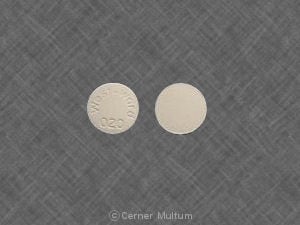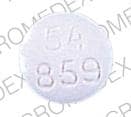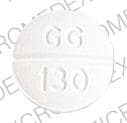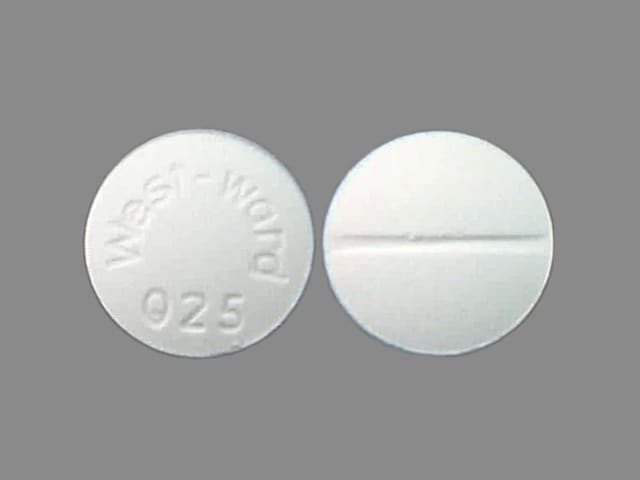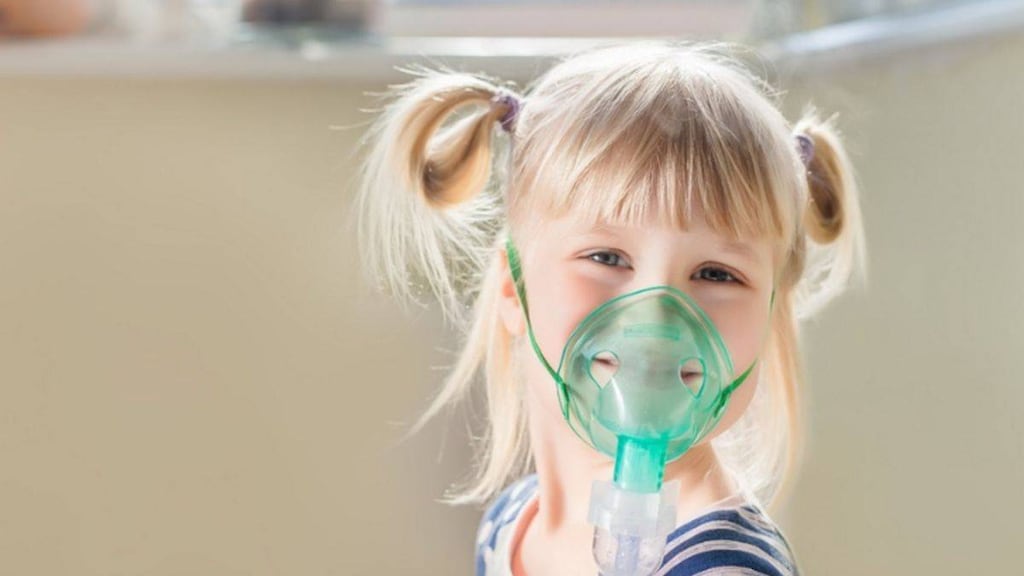Dosage Forms
Excipient information presented when available (limited, particularly for generics); consult specific product labeling.
Solution, Intravenous, as dihydrate:
Generic: 25 mg/mL (10 mL, 20 mL)
Pharmacology
Mechanism of Action
Theophylline has two distinct actions; smooth muscle relaxation (ie, bronchodilation) and suppression of the response of the airways to stimuli (ie, non-bronchodilator prophylactic effects). Bronchodilation is mediated by inhibition of two isoenzymes, phosphodiesterase (PDE III and, to a lesser extent, PDE IV) while non-bronchodilation effects are mediated through other molecular mechanisms. Theophylline increases the force of contraction of diaphragmatic muscles through enhancement of calcium uptake through adenosine-mediated channels.
Pharmacokinetics/Pharmacodynamics
Distribution
Theophylline: ~0.45 L/kg based on ideal body weight; distributes poorly into body fat; Vd may increase in premature neonates, hepatic cirrhosis, acidemia (uncorrected), elderly, and third trimester of pregnancy.
Metabolism
Theophylline: Hepatic via demethylation (CYP 1A2) and hydroxylation (CYP 2E1 and 3A4); forms active metabolites (caffeine and 3-methylxanthine).
Excretion
Theophylline: Urine (~50% as unchanged drug [Neonates]; ~10% as unchanged drug [Infants >3 months, Adolescents, and Adults])
Time to Peak
Serum: Theophylline: Within 30 minutes
Half-Life Elimination
Theophylline: Highly variable and dependent upon age, hepatic function, cardiac function, lung disease, and smoking history
Premature infants, postnatal age 3 to 15 days: 30 hours (range: 17 to 43 hours)
Premature infants, postnatal age 25 to 57 days: 20 hours (range: 9.4 to 30.6 hours)
Term infants, postnatal age 1 to 2 days: 25.7 hours (range: 25 to 26.5 hours)
Term infants, postnatal age 3 to 30 weeks: 11 hours (range: 6 to 29 hours)
Children 1 to 4 years: 3.4 hours (range: 1.2 to 5.6 hours)
Children and Adolescents 6 to 17 years: 3.7 hours (range: 1.5 to 5.9 hours)
Adults ≥18 years to ≤60 years (asthma, nonsmoking, otherwise healthy): 8.7 hours (range: 6.1 to 12.8 hours)
Elderly >60 years (nonsmoking, healthy): 9.8 hours (range: 1.6 to 18 hours)
Protein Binding
Theophylline: ~40%, primarily to albumin; decreased in neonates (due to a greater percentage of fetal albumin), hepatic cirrhosis, acidemia (uncorrected), elderly, third trimester of pregnancy.
Use in Specific Populations
Special Populations: Renal Function Impairment
Clearance is decreased in infants <3 months with decreased renal function.
Special Populations: Hepatic Function Impairment
Clearance is decreased by ≥50% in patients with hepatic impairment (eg, cirrhosis, acute hepatitis, cholestasis).
Special Populations: Elderly
Clearance is decreased by an average of 30% in patients >60 years.
Special Populations: Children
Clearance is very low in neonates and reaches max values by 1 year of age, remains relatively constant until about 9 years of age, and then slowly decreases by approximately 50% to adult values at about 16 years of age. Renal excretion of unchanged theophylline in neonates amounts to about 50% of the dose, compared to about 10% in children older than three months and in adults.
Special Populations: Gender
Significant reduction in theophylline clearance has been reported in women on the 20th day of the menstrual cycle and during the third trimester of pregnancy.
Special Populations Note
Smoking: Clearance is increased by smoking (ie, marijuana or tobacco) by ~50% in young adult and ~80% in elderly tobacco smokers. Cessation of smoking for 1 week causes a reduction in theophylline clearance by ~40%.
Use: Labeled Indications
Reversible airflow obstruction: Treatment of acute exacerbations of symptoms and reversible airflow obstruction due to asthma or other chronic lung diseases (eg, emphysema, chronic bronchitis) as an adjunct to inhaled beta-2 selective agonists and systemically administered corticosteroids.
Guideline recommendations:
Asthma: The 2007 National Heart, Lung, and Blood Institute Asthma Guidelines and the 2018 Global Initiative for Asthma Guidelines (GINA) recommend against aminophylline for the treatment of asthma exacerbations because of poor efficacy and safety concerns (GINA 2018; NAEPP 2007).
COPD: The 2018 Global Initiative for Chronic Obstructive Lung Disease Guidelines recommends against aminophylline for the treatment of COPD exacerbations because of significant adverse effects (GOLD 2018).
Use: Off Label
Reversal of dipyridamole- or regadenoson-induced adverse reactions (eg, angina, hypotension) during nuclear cardiac stress testingyes
Based on the American Society of Nuclear Cardiology (ASNC) Guidelines for Nuclear Cardiology Procedures, aminophylline given for the reversal of adenosine-, dipyridamole-, or regadenoson-induced adverse reactions (eg, angina, hypotension) during nuclear cardiac stress testing is effective and recommended in this setting. Use of aminophylline with adenosine-induced adverse reactions specifically is usually not warranted due to adenosine's short half-life (adverse reactions will usually stop within seconds of stopping adenosine). In the setting of aminophylline shortage, theophylline or caffeine may be used as alternatives to reverse regadenoson or dipyridamole. In addition, to reduce aminophylline use overall, adenosine or dobutamine can be used as alternative pharmacologic testing agents, if appropriate, since aminophylline reversal is not typically required Singleton 2018.
Contraindications
Hypersensitivity to aminophylline, theophylline, ethylenediamine, or any component of the formulation.
Canadian labeling: Additional contraindications (not in US labeling): Coronary artery disease where cardiac stimulation might prove harmful; peptic ulcer disease.
Dosage and Administration
Dosing: Adult
Note: All dosages expressed as aminophylline; use ideal body weight (theophylline distributes poorly into body fat) to calculate dose; individualize dose based on steady-state serum concentrations. Theophylline dose is ~79% of aminophylline dose. The treatment of asthma exacerbations with aminophylline is not supported or recommended by current clinical practice guidelines (GINA 2018; NAEPP 2007). The treatment of acute COPD exacerbations with aminophylline is not recommended by current clinical practice guidelines (Global Initiative for COPD Guidelines 2018).
Reversible airflow obstruction, acute symptoms:
Loading dose: IV:
Patients who have not received aminophylline or theophylline in the previous 24 hours: 5.7 mg/kg.
Patients who have received aminophylline or theophylline in the previous 24 hours: A loading dose should not be given before obtaining a serum theophylline concentration. The loading dose should be calculated as follows:
Loading dose = (desired serum theophylline concentration - measured serum theophylline concentration) (Vd)
Maintenance dose: IV: Note: Dosing presented is to achieve a target theophylline concentration of 10 mcg/mL. Lower initial doses may be required in patients with reduced theophylline clearance. Dosage should be adjusted according to serum level measurements.
Adults ≤60 years: 0.51 mg/kg/hour; maximum dose: 1,139 mg/day unless serum levels indicate need for larger dose.
Adults >60 years: 0.38 mg/kg/hour; maximum dose: 507 mg/day unless serum levels indicate need for larger dose.
Cardiac decompensation, cor pulmonale, sepsis with multiorgan failure, and shock: 0.25 mg/kg/hour; maximum dose: 507 mg/day unless serum levels indicate need for larger dose.
Dosage adjustment based on serum theophylline concentrations: Note: Recheck serum theophylline concentration 24 hours after dosage adjustment.
<9.9 mcg/mL: If dosage is tolerated, but symptoms are not controlled, increase infusion rate ~25%.
10 to 14.9 mcg/mL: Maintain infusion rate if dosage is tolerated and symptoms controlled. Recheck serum concentrations at 24-hour intervals. If symptoms are not controlled and dosage is tolerated, consider adding additional medications to treatment regimen.
15 to 19.9 mcg/mL: Consider 10% dose reduction in infusion rate to improve safety margin even if dose is tolerated.
20 to 24.9 mcg/mL: Decrease infusion rate by 25% even if no adverse effects present.
25 to 30 mcg/mL: Stop infusion for 24 hours and decrease subsequent infusion rate at least 25%. If symptomatic, stop infusion and consider whether overdose treatment is indicated.
>30 mcg/mL: Stop infusion and treat overdose; if resumed, decrease subsequent infusion rate at least 50%.
Reversal of dipyridamole- or regadenoson-induced adverse reactions (eg, angina, hypotension) during nuclear cardiac stress testing (off-label use): IV: 50 to 250 mg administered over 30 to 60 seconds, repeat as necessary. Note: Since adenosine-induced side effects are short lived after discontinuation of the infusion, aminophylline administration is only very rarely required (ASNC [Henzlova 2016]). In the setting of aminophylline shortage, IV theophylline or caffeine may be used as alternatives (Singleton 2018).
Dosing: Geriatric
Refer to adult dosing. Maximum dose: 507 mg/day unless serum levels indicate need for a larger dose.
Dosing: Pediatric
Note: All dosages expressed as aminophylline; use ideal body weight to calculate dose; adjust dose based on steady-state serum concentrations.
Reversible airflow obstruction, acute symptoms: Infants, Children, and Adolescents: Note: Not recommended for the treatment of asthma exacerbations (GINA 2018; NAEPP 2007).
Loading dose: IV:
Patients not currently receiving aminophylline or theophylline: 5.7 mg/kg/dose
Patients currently receiving aminophylline or theophylline: A loading dose is not recommended without first obtaining a serum theophylline concentration in patients who have received aminophylline or theophylline within the past 24 hours. The loading dose should be calculated as follows:
Dose = (C desired – C measured) (Vd)
C desired = desired serum theophylline concentration
C measured = measured serum theophylline concentration
Maintenance dose: Continuous IV infusion: Note: Dosing presented is to achieve a target concentration of 10 mcg/mL. Lower initial doses may be required in patients with reduced theophylline clearance. Dosage should be adjusted according to serum concentration measurements during the first 12- to 24-hour period.
Infants 4 to 6 weeks: 1.9 mg/kg/dose every 12 hours
Infants 6 to 52 weeks: Dose (mg/kg/hour) = [(0.008 X age in weeks) + 0.21] divided by 0.79
Children 1 to <9 years: 1.01 mg/kg/hour
Children 9 to <12 years: 0.89 mg/kg/hour
Adolescents 12 to <16 years (otherwise healthy, nonsmokers): 0.63 mg/kg/hour; maximum dose: 1,139 mg/day unless serum concentrations indicate need for larger dose
Adolescents 12 to <16 years (cigarette or marijuana smokers): 0.89 mg/kg/hour
Adolescents ≥16 years (otherwise healthy, nonsmokers): 0.51 mg/kg/hour; maximum dose: 1,139 mg/day unless serum concentrations indicate need for larger dose
Cardiac decompensation, cor pulmonale, hepatic dysfunction, sepsis with multiorgan failure, shock: Infants, Children, and Adolescents: Initial: 0.25 mg/kg/hour; maximum dose: 507 mg/day unless serum concentrations indicate need for larger dose.
Dosage adjustment based on serum theophylline concentrations: Infants, Children, and Adolescents: Note: Recheck serum theophylline concentrations in 12 hours (ages 1 month to <16 years) or 24 hours (ages ≥16 years) after IV dose; adjust dose based on the following serum concentration results:
<9.9 mcg/mL: If tolerated, but symptoms remain, increase dose by ~25%. Recheck serum theophylline concentrations.
10 to 14.9 mcg/mL: Maintain dosage if tolerated and symptoms controlled. Recheck serum concentrations at 24-hour intervals. If symptoms not controlled, consider additional medications for management.
15 to 19.9 mcg/mL: Consider 10% dose reduction to improve safety margin even if dose is tolerated.
20 to 24.9 mcg/mL: Decrease dose by ~25%. Recheck serum concentrations.
25 to 30 mcg/mL: Stop infusion for 12 hours (ages 1 month to <16 years) or 24 hours (ages ≥16 years) and decrease subsequent doses by at least 25%. Recheck serum concentrations.
>30 mcg/mL: Stop dosing and treat overdose; if resumed, decrease subsequent doses by at least 50%. Recheck serum concentrations.
Administration
IV: For IV administration only. Loading doses should be administered IV over 30 minutes. In patients with cor pulmonale, cardiac decompensation, hepatic impairment, patients >60 years of age, or patients taking medications that reduce theophylline clearance, the initial maintenance infusion rate should not exceed 21 mg/hour.
Off-label use: For reversal of adenosine-, dipyridamole-, or regadenoson-induced adverse events during nuclear cardiac stress testing, administer IV undiluted over 30 to 60 seconds, repeat as necessary. Since adenosine-induced side effects are short lived after discontinuation of the infusion, aminophylline administration is only very rarely required (ASNC [Henzlova 2016]).
Vesicant; ensure proper needle or catheter placement prior to and during IV infusion. Avoid extravasation.
Extravasation management: If extravasation occurs, stop infusion immediately and disconnect (leave needle/cannula in place); gently aspirate extravasated solution (do NOT flush the line); initiate hyaluronidase antidote; remove needle/cannula; apply dry cold compresses (Hurst 2004; Reynolds 2014); elevate extremity.
Hyaluronidase: Intradermal or SubQ: Inject a total of 1 to 1.7 mL (15 units/mL) as five separate 0.2 to 0.3 mL injections (using a 25-gauge needle) into area of extravasation at the leading edge in a clockwise manner (MacCara 1983; Reynolds 2014; Zenk 1981).
Storage
Store at 20°C to 25°C (68°F to 77°F) in original carton. Protect from light. Do not use if discolored or if crystals are present.
Aminophylline Images
Drug Interactions
Acebrophylline: May enhance the stimulatory effect of Theophylline Derivatives. Avoid combination
Adalimumab: May decrease the serum concentration of Theophylline Derivatives. Monitor therapy
Adenosine: Theophylline Derivatives may diminish the therapeutic effect of Adenosine. Consider therapy modification
Alcohol (Ethyl): May increase the serum concentration of Aminophylline. Monitor therapy
Allopurinol: May increase the serum concentration of Theophylline Derivatives. Monitor therapy
Amifampridine: Agents With Seizure Threshold Lowering Potential may enhance the neuroexcitatory and/or seizure-potentiating effect of Amifampridine. Monitor therapy
Antithyroid Agents: May increase the serum concentration of Theophylline Derivatives. Monitor therapy
AtoMOXetine: May enhance the hypertensive effect of Sympathomimetics. AtoMOXetine may enhance the tachycardic effect of Sympathomimetics. Monitor therapy
Barbiturates: May decrease the serum concentration of Theophylline Derivatives. Monitor therapy
Benzodiazepines: Theophylline Derivatives may diminish the therapeutic effect of Benzodiazepines. Consider therapy modification
Beta-Blockers (Beta1 Selective): May diminish the bronchodilatory effect of Theophylline Derivatives. Management: Monitor for reduced theophylline efficacy during concomitant use with any beta-blocker. Beta-1 selective agents are less likely to antagonize theophylline than nonselective agents, but selectivity may be lost at higher doses. Monitor therapy
Beta-Blockers (Nonselective): May diminish the bronchodilatory effect of Theophylline Derivatives. Monitor therapy
Broccoli: May decrease the serum concentration of CYP1A2 Substrates (High risk with Inducers). Monitor therapy
BuPROPion: May enhance the neuroexcitatory and/or seizure-potentiating effect of Agents With Seizure Threshold Lowering Potential. Monitor therapy
Cambendazole: May increase the serum concentration of Theophylline Derivatives. Monitor therapy
Cannabinoid-Containing Products: May enhance the tachycardic effect of Sympathomimetics. Exceptions: Cannabidiol. Monitor therapy
Cannabis: May decrease the serum concentration of CYP1A2 Substrates (High risk with Inducers). Monitor therapy
CarBAMazepine: May decrease the serum concentration of Theophylline Derivatives. Theophylline Derivatives may decrease the serum concentration of CarBAMazepine. Management: Seek alternatives to this combination when possible. If these agents are used together, monitor closely for decreased serum concentrations/therapeutic effects of both medications. Consider therapy modification
Cocaine (Topical): May enhance the hypertensive effect of Sympathomimetics. Management: Consider alternatives to use of this combination when possible. Monitor closely for substantially increased blood pressure or heart rate and for any evidence of myocardial ischemia with concurrent use. Consider therapy modification
CYP1A2 Inducers (Moderate): May decrease the serum concentration of Theophylline Derivatives. Monitor therapy
CYP1A2 Inhibitors (Moderate): May increase the serum concentration of Theophylline Derivatives. Management: Consider avoidance of this combination. If coadministration is necessary, monitor for increased theophylline serum concentrations and toxicities when combined. Theophylline dose reductions will likely be required. Consider therapy modification
CYP1A2 Inhibitors (Strong): May increase the serum concentration of Theophylline Derivatives. Management: Consider avoidance of this combination. If coadministration is necessary, consider an empiric theophylline dose reduction to one-third of the original theophylline dose. Monitor for increased theophylline serum concentrations and toxicities when combined. Consider therapy modification
CYP1A2 Inhibitors (Weak): May increase the serum concentration of Theophylline Derivatives. Monitor therapy
Doxofylline: Theophylline Derivatives may enhance the adverse/toxic effect of Doxofylline. Avoid combination
Febuxostat: May increase serum concentrations of the active metabolite(s) of Theophylline Derivatives. Specifically, concentrations of 1-methylxanthine, a metabolite of unknown clinical importance, may become elevated. Monitor therapy
Fluconazole: May increase the serum concentration of Theophylline Derivatives. Monitor therapy
Formoterol: Theophylline Derivatives may enhance the adverse/toxic effect of Formoterol. Theophylline Derivatives may enhance the hypokalemic effect of Formoterol. Monitor therapy
Fosphenytoin: May decrease the serum concentration of Theophylline Derivatives. Theophylline Derivatives may decrease the serum concentration of Fosphenytoin. Management: Seek alternatives when possible. If used together, monitor for decreased concentrations/effects of phenytoin or theophylline if the other agent is initiated/dose increased, or increased concentrations/effects if the other is discontinued/dose decreased. Consider therapy modification
Guanethidine: May enhance the arrhythmogenic effect of Sympathomimetics. Guanethidine may enhance the hypertensive effect of Sympathomimetics. Monitor therapy
Indacaterol: Theophylline Derivatives may enhance the adverse/toxic effect of Indacaterol. Theophylline Derivatives may enhance the hypokalemic effect of Indacaterol. Monitor therapy
Iohexol: Agents With Seizure Threshold Lowering Potential may enhance the adverse/toxic effect of Iohexol. Specifically, the risk for seizures may be increased. Management: Discontinue agents that may lower the seizure threshold 48 hours prior to intrathecal use of iohexol. Wait at least 24 hours after the procedure to resume such agents. In nonelective procedures, consider use of prophylactic anticonvulsants. Consider therapy modification
Iomeprol: Agents With Seizure Threshold Lowering Potential may enhance the adverse/toxic effect of Iomeprol. Specifically, the risk for seizures may be increased. Management: Discontinue agents that may lower the seizure threshold 48 hours prior to intrathecal use of iomeprol. Wait at least 24 hours after the procedure to resume such agents. In nonelective procedures, consider use of prophylactic anticonvulsants. Consider therapy modification
Iopamidol: Agents With Seizure Threshold Lowering Potential may enhance the adverse/toxic effect of Iopamidol. Specifically, the risk for seizures may be increased. Management: Discontinue agents that may lower the seizure threshold 48 hours prior to intrathecal use of iopamidol. Wait at least 24 hours after the procedure to resume such agents. In nonelective procedures, consider use of prophylactic anticonvulsants. Consider therapy modification
Isoniazid: May increase the serum concentration of Theophylline Derivatives. Monitor therapy
Isoproterenol: May decrease the serum concentration of Theophylline Derivatives. Monitor therapy
Linezolid: May enhance the hypertensive effect of Sympathomimetics. Management: Reduce initial doses of sympathomimetic agents, and closely monitor for enhanced pressor response, in patients receiving linezolid. Specific dose adjustment recommendations are not presently available. Consider therapy modification
Lithium: Theophylline Derivatives may decrease the serum concentration of Lithium. Monitor therapy
Macrolide Antibiotics: May decrease the metabolism of Theophylline Derivatives. Exceptions: Azithromycin (Systemic); Fidaxomicin; Roxithromycin; Spiramycin; Telithromycin. Consider therapy modification
Methotrexate: May increase the serum concentration of Theophylline Derivatives. Monitor therapy
Olodaterol: Theophylline Derivatives may enhance the adverse/toxic effect of Olodaterol. Theophylline Derivatives may enhance the hypokalemic effect of Olodaterol. Monitor therapy
Pancuronium: Theophylline Derivatives may enhance the adverse/toxic effect of Pancuronium. Theophylline Derivatives may diminish the neuromuscular-blocking effect of Pancuronium. Management: Pancuronium dosage adjustment may be necessary to induce paralysis in patients receiving concomitant theophylline derivatives. Monitor closely for adverse effects (e.g., cardiac effects) with concomitant use of these agents. Consider therapy modification
Pentoxifylline: May increase the serum concentration of Theophylline Derivatives. Monitor therapy
Phenytoin: May decrease the serum concentration of Theophylline Derivatives. Theophylline Derivatives may decrease the serum concentration of Phenytoin. Management: Seek alternatives when possible. If used together, monitor for decreased concentrations/effects of phenytoin or theophylline if the other agent is initiated/dose increased, or increased concentrations/effects if the other is discontinued/dose decreased. Consider therapy modification
QuiNINE: May increase the serum concentration of Theophylline Derivatives. Monitor therapy
Quinolones: May decrease the metabolism of Theophylline Derivatives. Ciprofloxacin and enoxacin are of greatest concern. Theophylline/quinolone therapy might augment the seizure-producing potential of each of the individual agents. Exceptions: Delafloxacin; Gemifloxacin; LevoFLOXacin (Systemic); Lomefloxacin; Moxifloxacin (Systemic); Nalidixic Acid; Pefloxacin; Sparfloxacin. Consider therapy modification
Regadenoson: Aminophylline may diminish the vasodilatory effect of Regadenoson. Consider therapy modification
Riociguat: Theophylline Derivatives may enhance the hypotensive effect of Riociguat. Avoid combination
Ritonavir: May decrease the serum concentration of Theophylline Derivatives. Monitor therapy
Solriamfetol: Sympathomimetics may enhance the hypertensive effect of Solriamfetol. Monitor therapy
Sulfinpyrazone: May decrease the serum concentration of Theophylline Derivatives. Monitor therapy
Sympathomimetics: May enhance the adverse/toxic effect of other Sympathomimetics. Monitor therapy
Tedizolid: May enhance the hypertensive effect of Sympathomimetics. Tedizolid may enhance the tachycardic effect of Sympathomimetics. Monitor therapy
Thiopental: Aminophylline may diminish the therapeutic effect of Thiopental. Monitor therapy
Thyroid Products: May increase the metabolism of Theophylline Derivatives. Monitor therapy
Tobacco (Smoked): May decrease the serum concentration of Theophylline Derivatives. Monitor therapy
Verapamil: May increase the serum concentration of Theophylline Derivatives. Monitor therapy
Zafirlukast: Theophylline Derivatives may decrease the serum concentration of Zafirlukast. Zafirlukast may increase the serum concentration of Theophylline Derivatives. Monitor therapy
Test Interactions
Plasma glucose, uric acid, free fatty acids, total cholesterol, HDL, HDL/LDL ratio, and urinary free cortisol excretion may be increased by theophylline. Theophylline may decrease triiodothyronine.
Adverse Reactions
Frequency not defined. Adverse events observed at therapeutic serum levels:
Central nervous system: Headache, insomnia, irritability, restlessness, seizure
Dermatologic: Allergic skin reaction, exfoliative dermatitis
Gastrointestinal: Diarrhea, nausea, vomiting
Genitourinary: Diuresis (transient)
Neuromuscular & skeletal: Tremor
Warnings/Precautions
Concerns related to adverse effects:
- Extravasation: Vesicant; ensure proper catheter or needle position prior to and during infusion. Avoid extravasation.
- Theophylline toxicity: Severe and potentially fatal theophylline toxicity may occur if reduced theophylline clearance occurs. Theophylline clearance may be decreased in patients with acute pulmonary edema, heart failure, cor pulmonale, fever (≥102°F for ≥24 hours or lesser temperature elevations for longer periods), hepatic disease, acute hepatitis, cirrhosis, hypothyroidism, sepsis with multiorgan failure, shock, neonates (term and premature), infants <3 months of age with decreased renal function, infants <1 year, elderly >60 years, and patients following cessation of smoking. Consider benefits versus risks and the need for more intensive monitoring in these patients; reduced infusion rate required. If a patient develops signs and symptoms of theophylline toxicity (eg, nausea or persistent, repetitive vomiting), a serum theophylline level should be measured immediately and subsequent doses withheld.
Disease-related concerns:
- Cardiovascular disease: Use with caution in patients with cardiac arrhythmias (excluding bradyarrhythmias); use may exacerbate arrhythmias.
- Cystic fibrosis: Use with caution in patients with cystic fibrosis; increased theophylline clearance may occur.
- Hepatic impairment: Use with caution in patients with hepatic impairment (eg, cirrhosis, acute hepatitis, cholestasis); risk of severe and potentially fatal theophylline toxicity is increased. Theophylline clearance is decreased ≥50% in these patients. Dose reduction and frequent monitoring of serum theophylline concentrations are required.
- Hyperthyroidism: Use with caution in patients with hyperthyroidism; increased theophylline clearance may occur.
- Peptic ulcer disease: Use with caution in patients with active peptic ulcer disease; use may exacerbate peptic ulcer.
- Seizure disorder: Use with caution in patients with seizure disorders; use may exacerbate seizure disorder.
Concurrent drug therapy issues:
- Drug-drug interactions: Potentially significant interactions may exist, requiring dose or frequency adjustment, additional monitoring, and/or selection of alternative therapy. Consult drug interactions database for more detailed information.
Special populations:
- Elderly: Use extreme caution in the elderly; these patients are at greater risk of serious theophylline toxicity.
- Pediatric: Select dose with caution and with frequent monitoring of concentrations (especially <1 year); rate of clearance is highly variable in these patients.
Other warnings/precautions:
- Appropriate use: Do not increase dose in response to acute exacerbation of symptoms unless steady state serum theophylline concentration is <10 mcg/mL. As the rate of theophylline clearance may be dose-dependent, an increase in dose based upon a subtherapeutic serum concentration measurement should be limited to ~25% increase of the previous infusion rate or daily dose.
Monitoring Parameters
Heart rate; CNS effects (insomnia, irritability); respiratory rate (COPD patients often have resting controlled respiratory rates in low 20s); arterial or capillary blood gases (if applicable)
Theophylline levels: Serum theophylline levels should be monitored after initiation of therapy and prior to making dose increases; in the presence of signs or symptoms of toxicity; or when a new illness, worsening of a present illness, or change in patient’s treatment regimen that may alter theophylline clearance (eg, fever >102°F or sustained for 24 hours or more, hepatitis, or drugs that are added or discontinued); changes in fluid balance; electrolyte concentrations, acid-base balance during prolonged therapy.
Loading dose: Measure serum concentrations 30 minutes after the end of an IV loading dose in patients who have not received theophylline in the previous 24 hours to determine the need for an additional loading (serum concentration <10 mcg/mL) or to delay starting the constant IV infusion (serum concentration >20 mcg/mL).
Infusion: Measure serum concentrations one half-life (eg, ~4 hours in children 1 to 9 years of age or 8 hours in nonsmoking, otherwise healthy adults) after starting a continuous infusion, then every 12 to 24 hours for duration of infusion; measure more frequently in acutely ill patients.
Monitor infusion site.
Pregnancy
Pregnancy Considerations
Aminophylline is a complex of theophylline and ethylenediamine. Theophylline crosses the placenta. Refer to Theophylline monograph for additional information.
Patient Education
What is this drug used for?
- It is used to treat breathing problems.
Frequently reported side effects of this drug
- Diarrhea
- Anxiety
- Headache
- Abdominal pain
- Agitation
- Trouble sleeping
- Passing a lot of urine
Other side effects of this drug: Talk with your doctor right away if you have any of these signs of:
- Low potassium like muscle pain or weakness, muscle cramps, or an abnormal heartbeat.
- High blood sugar like confusion, fatigue, increased thirst, increased hunger, passing a lot of urine, flushing, fast breathing, or breath that smells like fruit.
- Muscle pain
- Muscle weakness
- Fast heartbeat
- Abnormal heartbeat
- Fast breathing
- Severe dizziness
- Passing out
- Nausea
- Vomiting
- Irritability
- Confusion
- Seizures
- Tremors
- Signs of a significant reaction like wheezing; chest tightness; fever; itching; bad cough; blue skin color; seizures; or swelling of face, lips, tongue, or throat.
Note: This is not a comprehensive list of all side effects. Talk to your doctor if you have questions.
Consumer Information Use and Disclaimer: This information should not be used to decide whether or not to take this medicine or any other medicine. Only the healthcare provider has the knowledge and training to decide which medicines are right for a specific patient. This information does not endorse any medicine as safe, effective, or approved for treating any patient or health condition. This is only a brief summary of general information about this medicine. It does NOT include all information about the possible uses, directions, warnings, precautions, interactions, adverse effects, or risks that may apply to this medicine. This information is not specific medical advice and does not replace information you receive from the healthcare provider. You must talk with the healthcare provider for complete information about the risks and benefits of using this medicine.
